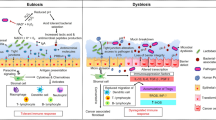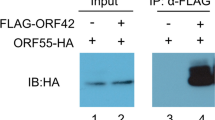Abstract
The High-Risk Human Papillomaviruses (HR-HPVs) 16 and 18 are known to cause cervical cancer, which is primarily attributed to E6 and E7 oncoproteins. In addition, recent studies have focused on the vital role of the p130 pocket protein as an oncosuppressor to limit the expression of E2F transcription factors required for cell cycle progression. In view of this, the current study was conducted to investigate the mechanism by which transfection with HPV16/18 E7 leads to the deregulation of the host cell cycle, altering the localisation of p130, and expression of differentiation genes in Human Keratinocytes (HaCaT) cells. Co-immunoprecipitation, Western blot analysis, immunofluorescence microscopy, flow cytometry, quantitative-Polymerase Chain Reaction (qPCR), and the inhibition of p130 by MG132 inhibitor were employed to investigate the loss of p130 and its disruption in HPV 16/18 E7-transfected HaCaT cells. The HPV16- and HPV18-transformed cells, known as CaSki and HeLa, respectively, were also used to complement the ectopic expressions of E7 in HaCaT cells. Normal keratinocytes displayed higher level of p130 expression than HPV-transformed cells. In addition, the immunofluorescence analysis revealed that both HPV 16/18 E7-transfected HaCaT and HPV-transformed cells exhibited higher level of cytoplasmic p130 compared to nuclear p130. A significant increase in the number of S/G2 phase cells in HPV-transformed cells was also recorded since E7 has been shown to stimulate proliferation through the deactivation of Retinoblastoma Protein (pRB)-dependent G1/S checkpoint. Furthermore, the findings recorded the down-regulation of keratinocyte differentiation markers, namely p130, keratin10, and involucrin. The proteasomal degradation of the exported p130 confirmed the cellular localisation pattern of p130, which was commonly observed in cancerous cells. The findings provide strong evidence that the localisation of nuclear p130 nuclear was disrupted by HPV16/18 E7 led to the deregulation of the cell cycle and the impairment of cellular differentiation ultimately lead to cellular transformation.





Similar content being viewed by others
Availability of data and materials
The datasets generated during and/or analyzed during the current study are available from the corresponding author on reasonable request.
References
Wang X, Huang X, Zhang Y (2018) Involvement of human papillomaviruses in cervical cancer. Front Microbiol 9:2896
Tomaić V (2016) Functional roles of E6 and E7 oncoproteins in HPV-induced malignancies at diverse anatomical sites. Cancers (Basel) 8:95
Alhamlan FS, AlAhdal MN, Al-Zahrani AS, Almatrrouk SA (2017) Human papillomaviruses: the cervical cancer saga in developing countries. J Infect Dev Ctries 11:819–825
Small W Jr, Bacon MA, Bajaj A et al (2017) Cervical cancer: a global health crisis. Cancer 123:2404–2412
Berman TA, Schiller JT (2017) Human papillomavirus in cervical cancer and oropharyngeal cancer: one cause, two diseases. Cancer 123:2219–2229
White EA (2019) Manipulation of epithelial differentiation by HPV oncoproteins. Viruses 11:369
El Abidine AZ, Tomaić V, Rhouma RBH et al (2017) A naturally occurring variant of HPV-16 E7 exerts increased transforming activity through acquisition of an additional phospho-acceptor site. Virology 500:218–225
Collins AS, Nakahara T, Do A, Lambert PF (2005) Interactions with pocket proteins contribute to the role of human papillomavirus type 16 E7 in the papillomavirus life cycle. J Virol 79:14769–14780
Schmit F, Korenjak M, Mannefeld M et al (2007) LINC, a human complex that is related to pRB-containing complexes in invertebrates regulates the expression of G2/M genes. Cell Cycle 6:1903–1913
Rashid NN, Yusof R, Watson RJ (2011) Disruption of repressive p130–DREAM complexes by human papillomavirus 16 E6/E7 oncoproteins is required for cell-cycle progression in cervical cancer cells. J Gen Virol 92:2620–2627
Rueden CT, Schindelin J, Hiner MC et al (2017) Image J2: ImageJ for the next generation of scientific image data. BMC Bioinform 18:1–26
Eidet JR, Pasovic L, Maria R, Jackson CJ, Utheim TP (2014) Objective assessment of changes in nuclear morphology and cell distribution following induction of apoptosis. Diagn Pathol 9:92–92
Colombo I, Sangiovanni E, Maggio R et al (2017) HaCaT cells as a reliable in vitro differentiation model to dissect the inflammatory/repair response of human keratinocytes. Mediators Inflamm 2017:7435621
Olson BJ (2016) Assays for determination of protein concentration. Curr Protoc Pharmacol 73:A-3A
Zhang B, Chen W, Roman A (2006) The E7 proteins of low-and high-risk human papillomaviruses share the ability to target the pRB family member p130 for degradation. Proc Natl Acad Sci USA 103:437–442
Zeeuwen PL, de Jongh GJ, Rodijk-Olthuis D et al (2008) Genetically programmed differences in epidermal host defense between psoriasis and atopic dermatitis patients. PLoS ONE 3:e2301
Hamel M, Dufort I, Robert C et al (2008) Identification of differentially expressed markers in human follicular cells associated with competent oocytes. Hum Reprod 23:1118–1127
Litovchick L, Sadasivam S, Florens L et al (2007) Evolutionarily conserved multisubunit RBL2/p130 and E2F4 protein complex represses human cell cycle-dependent genes in quiescence. Mol Cell 26:539–551
Ivanova IA, D’Souza SJ, Dagnino L (2005) Signalling in the epidermis: the E2F cell cycle regulatory pathway in epidermal morphogenesis, regeneration and transformation. Int J Biol Sci 1:87
Paramio JM, Laín S, Segrelles C, Lane EB, Jorcano JL (1998) Differential expression and functionally co-operative roles for the retinoblastoma family of proteins in epidermal differentiation. Oncogene 17:949–957
Degen M, Wiederkehr A, La Scala GC, Carmann C, Schnyder I, Katsaros C (2018) Keratinocytes isolated from individual cleft lip/palate patients display variations in their differentiation potential in vitro. Front Physiol 9:1703
Zhang Y, Yang B, Zhao J, Li X, Zhang L, Zhai Z (2018) Proteasome inhibitor carbobenzoxy-l-leucyl-l-leucyl-l-leucinal (MG132) enhances therapeutic effect of paclitaxel on breast cancer by inhibiting nuclear factor (NF)-κB signaling. Med Sci Monit 24:294
Estêvão D, Costa NR, da Costa RMG, Medeiros R (2019) Hallmarks of HPV carcinogenesis: the role of E6, E7 and E5 oncoproteins in cellular malignancy. Biochim Biophys Acta 1862:153–162
Đukić A, Lulić L, Thomas M et al (2020) HPV oncoproteins and the ubiquitin proteasome system: a signature of malignancy? Pathogens 9:133
Rashid NN, Rothan HA, Yusoff MSM (2015) The association of mammalian DREAM complex and HPV16 E7 proteins. Am J Cancer Res 5:3525
Laurson J, Raj K (2011) Localisation of human papillomavirus 16 E7 oncoprotein changes with cell confluence. PLoS ONE 6:e21501
Barrow-Laing L, Chen W, Roman A (2010) Low-and high-risk human papillomavirus E7 proteins regulate p130 differently. Virology 400:233–239
Hu L, Potapova TA, Li S et al (2010) Expression of HPV16 E5 produces enlarged nuclei and polyploidy through endoreplication. Virology 405:342–351
Ben-David U, Amon A (2020) Context is everything: aneuploidy in cancer. Nat Rev Genet 21:44–62
Yeo-Teh NSL, Ito Y, Jha S (2018) High-risk human papillomaviral oncogenes E6 and E7 target key cellular pathways to achieve oncogenesis. Int J Mol Sci 19:1706
DeCaprio JA (2014) Human papillomavirus type 16 E7 perturbs DREAM to promote cellular proliferation and mitotic gene expression. Oncogene 33:4036–4038
Hwang SG, Lee D, Kim J, Seo T, Choe J (2002) Human papillomavirus type 16 E7 binds to E2F1 and activates E2F1-driven transcription in a retinoblastoma protein-independent manner. J Biol Chem 277:2923–2930
Yasmeen A, Alachkar A, Dekhil H, Gambacorti-Passerini C, Al Moustafa A-E (2010) Locking Src/Abl tyrosine kinase activities regulate cell differentiation and invasion of human cervical cancer cells expressing E6/E7 oncoproteins of high-risk HPV. J Oncol. https://doi.org/10.1155/2010/530130
Moody C (2017) Mechanisms by which HPV induces a replication competent environment in differentiating keratinocytes. Viruses 9:261
Graham SV (2017) The human papillomavirus replication cycle, and its links to cancer progression: a comprehensive review. Clin Sci (Lond) 131:2201–2221
Hoskins EE, Morris TA, Higginbotham JM et al (2009) Fanconi anemia deficiency stimulates HPV-associated hyperplastic growth in organotypic epithelial raft culture. Oncogene 28:674–685
Iness AN, Felthousen J, Ananthapadmanabhan V et al (2019) The cell cycle regulatory DREAM complex is disrupted by high expression of oncogenic B-Myb. Oncogene 38:1080–1092
Soave CL, Guerin T, Liu J, Dou QP (2017) Targeting the ubiquitin-proteasome system for cancer treatment: discovering novel inhibitors from nature and drug repurposing. Cancer Metastasis Rev 36:717–736
Guiley KZ, Liban TJ, Felthousen JG, Ramanan P, Litovchick L, Rubin SM (2015) Structural mechanisms of DREAM complex assembly and regulation. Genes Dev 29:961–974
Acknowledgements
This work was supported by the Ministry of Higher Education, Malaysia under the Fundamental Research Grant Scheme FRGS/1/2016/SKK08/UM/02/16 (FP015-2016) and MyBrain15 Scholarship.
Funding
This work was supported by the Ministry of Higher Education, Malaysia under the Fundamental Research Grant Scheme FRGS/1/2016/SKK08/UM/02/16 (FP015-2016).
Author information
Authors and Affiliations
Contributions
All authors contributed to the study conception and design. Material preparation, data collections and analysis were performed by SG. The first draft of the manuscript was written by SG while NNR, MFMR and SO contributed to the manuscript revisions. All authors read and approved the final manuscript.
Corresponding author
Ethics declarations
Conflict of interest
The authors declare that they have no conflicts of interest.
Research involving human and/or animal participants
This article does not contain any studies with human participants or animals performed by any of the authors.
Additional information
Publisher's Note
Springer Nature remains neutral with regard to jurisdictional claims in published maps and institutional affiliations.
Supplementary Information
Below is the link to the electronic supplementary material.
Rights and permissions
About this article
Cite this article
Gandhi, S., Nor Rashid, N., Mohamad Razif, M.F. et al. Proteasomal degradation of p130 facilitate cell cycle deregulation and impairment of cellular differentiation in high-risk Human Papillomavirus 16 and 18 E7 transfected cells. Mol Biol Rep 48, 5121–5133 (2021). https://doi.org/10.1007/s11033-021-06509-4
Received:
Accepted:
Published:
Issue Date:
DOI: https://doi.org/10.1007/s11033-021-06509-4




